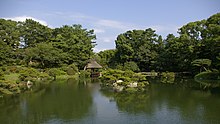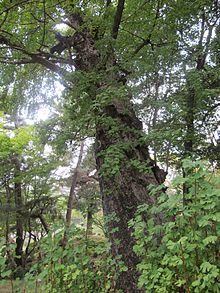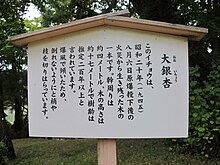Shukkei-en
The Shukkei-en ( Japanese 縮 景園 ) is a Japanese garden in the Naka-ku district of Hiroshima . It has a size of about 40,000 m².
construction
Shukkei means “compressed landscape” and refers to the fact that typical Japanese landscapes can be seen in reduced form in the garden.
In the center of the garden is the Takuei ( 濯 纓 池 , -chi ) pond , around which the landscapes are arranged. In the pond there are several islands on which small pine trees grow. The pond is spanned in the middle by a bridge, the Kokō-kyō ( 跨 虹橋 ). Carp and turtles live in the pond. The latter can be observed from the bank on Seifū-kan ( 清風 館 ).
The garden is designed as a convertible garden with a circular tour. The entrance is in the southwest. From here a path leads to Seifū-kan, a Sukiya tea house style building . If you walk around the pond clockwise, you will be prosecuted in the west into a forest region. Here is the Chōzen-kyo ( 超然 居 ). In the north there is a mountainous region with a rugged coastline. There are rivers that flow into small bays. The Meigetsu-tei ( 明月 亭 ) tea house is in this section.
In the east follows a mountain range, which is marked by the mountain Kifuku ( 祺 福山 , -san ). The Kokō-kyō, which spans the pond, ends at its foot. In the southeast there are garden landscapes, a tea garden and rice fields.
There is an herb garden in the southeast corner of the garden. The Prefecture Art Museum connects to the west of the garden area. There is an entrance from the garden.
history
In 1619 ( Genma 5) daimyo Asano Nagaakira ( 浅 野 長 晟 ; 1586-1632) made the castle of Hiroshima his residence. In the following year his follower Ueda Sōko ( 上 田 宗 箇 ; 1563-1650), a tea master, began building the garden. The garden was part of the villa at that time. Between 1783 and 1788 ( Tenmei 3-8), the garden was redesigned on the instructions of daimyo Asano Shigeakira ( 浅 野 重 晟 ; 1743-1818). Shimizu Shichirouemon ( 清水 七郎 右衛門 ), a garden architect from Kyoto, was responsible for the renovations .
In 1940 ( Shōwa 15) the garden became the property of Hiroshima Prefecture . In 1945 the entire garden was completely destroyed by the explosion of the atom bomb. The epicenter of the explosion was just 1.2 km away. Although not yet fully reconstructed, the garden reopened to the public in 1951. The Seifū-kan was only restored in 1964, the Meigetsu-tei in 1974.
There is an old ginkgo tree in the garden. A board on the tree notes: This ginkgo survived the firestorm as one of the trees after the atomic bomb was dropped on August 6, 1945. Trunk circumference: around 4 m, top height: around 17 m, age of the tree: estimated to be over 200 years. Tilted by the blast wind, pruning the branches prevents the tree from falling.
location
The garden is located in the Naka-ku district directly on the Kyobashigawa River and thus directly across from Hiroshima Central Station. It is located away from the Joban-dori, which leads from the main train station to the Hiroshima Castle area.
swell
- Leaflet of the garden
- Official website
Web links
- Official Website (Japanese)
Coordinates: 34 ° 24 ′ 1 ″ N , 132 ° 28 ′ 3 ″ E




